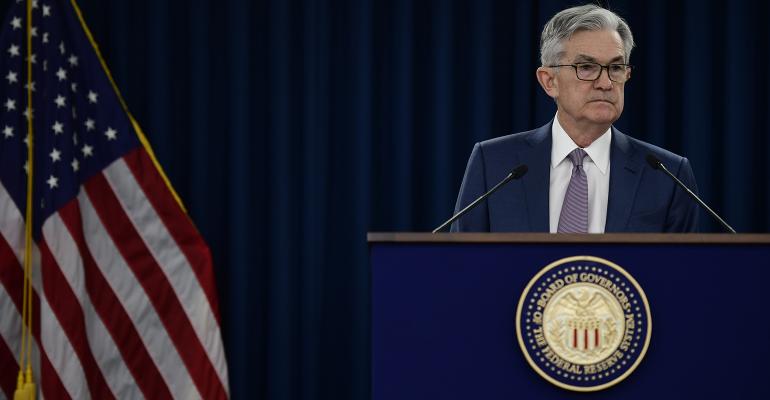(Bloomberg) -- Federal Reserve Chairman Jerome Powell said the coronavirus outbreak had increased risks to the U.S. economic outlook, prompting the central bank to deliver an emergency half-percentage point interest rate cut.
”My colleagues and I took this action to help the U.S. economy keep strong in the face of new risks to the economic outlook,” he told a hastily convened press conference in Washington on Tuesday. “The spread of the coronavirus has brought new challenges and risks.”
U.S. stocks initially advanced after the announcement before sliding into losses, while the 10-year Treasury yield neared 1%. Fed funds futures are pricing more than a percentage point of central bank rate reductions for 2020, including another quarter-point cut in the first half of the year.
The central bank said in its statement that it was “closely monitoring developments and their implications for the economic outlook and will use its tools and act as appropriate to support the economy.”
Powell, in response to a reporter question about the scope for further moves, said “we do like our current policy stance,” before repeating the Fed’s reference to taking action if needed.
G-7 Coordination
The Fed’s decision could presage a wave of easing from other central banks around the world although those in the euro-area and Japan have less scope to follow with rates already in negative territory.
It came hours after Powell and finance chiefs from the Group of Seven nations said they would “use all appropriate policy tools to achieve strong, sustainable growth and safeguard against downside risks.”
The vote for the rate cut to a range of 1% to 1.25% was unanimous. The Fed also said in the statement that the “fundamentals of the U.S. economy remain strong.”
The Fed move followed public pressure for a cut by President Donald Trump, whose stewardship of the economy is central to his reelection campaign this year. After today’s shift he called for more, demanding in a tweet that the Fed “must further ease and, most importantly, come into line with other countries/competitors. We are not playing on a level field. Not fair to USA.”
U.S. central bankers were scheduled to gather March 17-18 in Washington. Tuesday was the first time it had cut by more than 25 basis points since 2008.
The reduction marks a stark shift for Powell and his colleagues. They had previously projected no change in rates during 2020, remaining on the sidelines during the election year, after lowering their benchmark three times in 2019 to a range of 1.5% to 1.75%.
Clarida Stance
As recently as last week, some officials, including Vice Chairman Richard Clarida, had indicated they thought it was too soon to respond to the virus. They pledged to monitor the situation, but argued monetary policy was already easy and the fundamentals of the economy strong with unemployment near a 50-year low.
But as the number of reported cases of the virus rose around the world in recent days and the U.S. reported its first fatality, traders increasingly bet the Fed would step in. Powell seemed to cement that view with a promise on Friday to “act as appropriate,” which lent some support to stocks.
What Bloomberg’s Economists Say...
“We now anticipate an additional 50 bps of easing by midyear, in two consecutive 25 basis point cuts. Headlines related to the coronavirus will determine whether these begin in March or April.”
-- Carl Riccadonna, Yelena Shulyatyeva and Andrew Husby
Lower rates do little for factories lacking needed materials from abroad and are unlikely to spur consumers to shop if they’re scared of infection. But they should support consumer and business sentiment as well as ease financial conditions by making debt payments easier to manage and by calming market volatility.
Powell has staked his chairmanship on sustaining the expansion, words he has used to describe the essential mission of the Federal Open Market Committee, the Fed’s rate-setting panel. Despite the limited ability of monetary policy to ease the impact of a public health emergency, the rate cut could support consumer and business sentiment. Lawmakers are working on a $7.5 billion virus response bill, another reminder that critical fiscal policy can take weeks to move through Congress.
No Silver Bullet
One lesson Fed officials will take away from this moment is how rapidly their policy space is used up in a crisis.
Total cuts of one percentage point this year, which several Wall Street firms are forecasting, would bring the bottom range of the Fed policy rate down to 0.5%. If the virus impact is worse than expected, or if the economy is hit by a separate shock, the policy rate could strike zero.
At that point, Fed officials are left with unconventional tools, such as purchases of longer-dated Treasuries -- known as quantitative easing. The effectiveness of such tools when longer-term rates are already low remains to be seen.
The Fed is in the midst of a review of its tool kit to achieve its goal of maximum employment and stable prices. They are considering policies such as outcome-based forward guidance, where a policy change would be linked to some tangible metric such as achieving an inflation rate, and yield curve caps.
Wherever the discussion lands, the virus has highlighted the need for better fiscal and monetary policy coordination in a time of exceptionally low interest rates, says Julia Coronado, the president of MacroPolicy Perspectives.
The Fed is “carrying the domestic burden and the global burden,” Coronado said. “The fiscal policy response has been lacking. There are people that are going to be struggling to pay their bills and certain workers are going to lose incomes. This is the shock that needs to be insured and we are really behind the curve.”
--With assistance from Sophie Caronello, Alexandra Harris and Alister Bull.
To contact the reporter on this story:
Craig Torres in Washington at [email protected]
To contact the editors responsible for this story:
Margaret Collins at [email protected]
Scott Lanman





